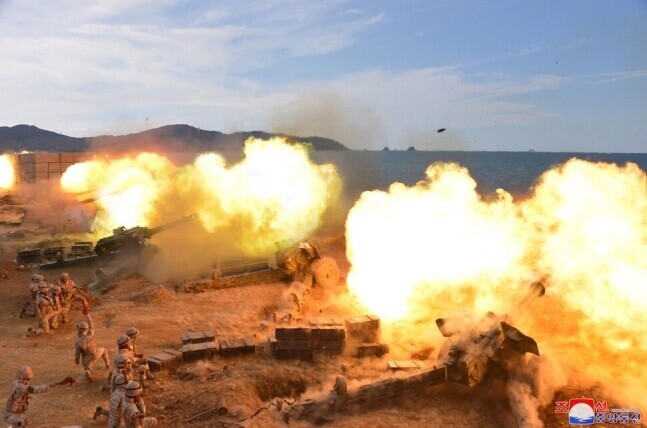hankyoreh
Links to other country sites 다른 나라 사이트 링크
N. Korea says South fell for “bait” of fake drills, S. Korea calls stunt a “low-level psyop”

North Korea conducted live-fire drills along its western coast from Friday through Sunday. The North’s Kim Yo-jong claimed on Saturday that the explosions were part of a “deceptive operation” designed to test the South’s reaction rather than drills. South Korea’s military declared that the drills were nothing more than “low-level psychological warfare.”
South Korea’s Joint Chiefs of Staff released a statement on Sunday stating that from around 4 pm to 5:10 pm that day, North Korea had fired over 90 artillery shells near the northern border of Yeonpyeong Island.
“We are keeping a close eye on the provocations from North Korea, which are expected as we approach this year’s general election, and have adopted a broad-gauge military readiness posture,” the Joint Chiefs added.
“In any instance of provocation from the enemy, we will respond swiftly and definitively with great force,” the Joint Chiefs warned.
The Joint Chiefs clarified that the North’s shells did not land south of the North Limit Line (NLL), the de facto maritime border.
On Friday, North Korea fired over 200 artillery shells from its Changsan Cape, just north of Baengnyeong Island. The shells mostly splashed into the maritime buffer zone, coming as close to 7 kilometers of the NLL. The following day, the Joint Chiefs announced that North Korea had fired over 60 shells into waters northwest of Yeonpyeong Island.
Kim Yo-jong, the vice department director of the Workers' Party of Korea Central Committee, wrote in a statement published by the North's official Korean Central News Agency on Sunday that the Korean People’s Army has “watched the reaction of the ROK military gangsters while detonating blasting powder simulating the sound of 130 mm coastal artillery for 60 times.”
Saying that the South had “misjudged” the sound to be gunfire and called it a provocation, Kim went on to claim that South Korea “made a false and impudent statement that the shells dropped in the sea buffer zone north of the ‘northern limit line’ in the West Sea.”
The “military gangsters” in South Korea, “quickly took the bait we threw,” she went on.
In short, Kim claims that the drills were nothing more than explosives designed to imitate the sound of artillery, and Seoul fell for Pyongyang’s ploy.
Addressing South Korea’s declaration of a swift and definitive response to any military provocations, Kim brazenly responded, “The military gangsters should bear in mind that they can ‘die instantly and forcefully and [to a permanent] end’ if they continue to resort to the so-called principle of counteraction such as ‘promptly, strongly and to the end’ often touted by them.”
On the same day, the state-run Korean Central Television broadcasted a 44-second video of explosions, claiming it was footage of the People’s Army’s “deceptive operation.”
The Joint Chiefs brushed off Kim’s claims as a “low-level psychological operation” regarding the South Korean military’s capacity to detect provocations and threats.
“It’s propaganda that’s so cheap it’s comedic. A typical North Korean ploy that only erodes their credibility and attempts to stir up conflict between two unrelated parties,” the Joint Chiefs added.
Since the nullification of the buffer-creating Sept. 19 inter-Korean military agreement signed in 2018, the probability of continuous psychological warfare and shows of military force from North Korea has become increasingly high.
“Now that the Sept. 19 inter-Korean military agreement is no longer being adhered to, North Korea has much more room to maneuver, and is taking advantage of that opportunity,” said Kim Dong-yup, a professor at the University of North Korean Studies.
“The current situation is even worse than before the military agreement,” Kim added.
By Shin Hyeong-cheol, staff reporter
Please direct questions or comments to [english@hani.co.kr]

Editorial・opinion
![[Column] Tariffs on China: Trump was dumb, Biden dumber [Column] Tariffs on China: Trump was dumb, Biden dumber](https://flexible.img.hani.co.kr/flexible/normal/500/300/imgdb/original/2024/0520/191716191153918.jpg) [Column] Tariffs on China: Trump was dumb, Biden dumber
[Column] Tariffs on China: Trump was dumb, Biden dumber![[Column] What if Seoul took reunification by force off the table? [Column] What if Seoul took reunification by force off the table?](https://flexible.img.hani.co.kr/flexible/normal/500/300/imgdb/original/2024/0520/3017161928630494.jpg) [Column] What if Seoul took reunification by force off the table?
[Column] What if Seoul took reunification by force off the table?- [Editorial] Intensifying US-China rivalry means Seoul must address uncertainty with Beijing sooner than later
- [Column] When ‘fairness’ means hate and violence
- [Editorial] Yoon must stop abusing authority to shield himself from investigation
- [Column] US troop withdrawal from Korea could be the Acheson Line all over
- [Column] How to win back readers who’ve turned to YouTube for news
- [Column] Welcome to the president’s pity party
- [Editorial] Korea must respond firmly to Japan’s attempt to usurp Line
- [Editorial] Transfers of prosecutors investigating Korea’s first lady send chilling message
Most viewed articles
- 1Xi, Putin ‘oppose acts of military intimidation’ against N. Korea by US in joint statement
- 2Kim Jong-un wanted to meet with residents of shelled Yeonpyeong Island in South, Moon recalls in mem
- 3To weigh costs and benefits, Korea must stop treating US troop presence as a sacred cow
- 4[Column] What if Seoul took reunification by force off the table?
- 5Berlin mayor hints at tearing down ‘comfort women’ memorial in city
- 6[Column] Tariffs on China: Trump was dumb, Biden dumber
- 7[Editorial] Transfers of prosecutors investigating Korea’s first lady send chilling message
- 8Naver’s union calls for action from government over possible Japanese buyout of Line
- 9[Exclusive] Truth commission to seek additional murder charges for figures behind 1980 Gwangju massa
- 10[Column] US troop withdrawal from Korea could be the Acheson Line all over